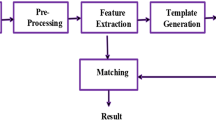Abstract
The two key factors in a biometric identification system are its high identification rate and convenience of device usage. In a finger-vein identification task, these two problems often occur since the captured device of finger-vein image should accommodate the high identification rate as well as the easy-to-use device design. The finger-vein is visually invisible inside the human skin. This work develops a new finger-vein capturing device using Near-Infrared (NIR) LED light and proposes an efficient technique for finger-vein identification. The vein image may contain noise and shadows due to device lighting conditions. Parametric-Oriented Histogram Equalization (POHE) is utilized to enhance image contrast and reduce the noise effect. This work also discusses normalized issues related to the angle correction of the finger edge and Region of Interest (ROI) for width normalization. In the experimental result, the proposed method yields a clear finger-vein pattern with a superior identification rate in the recognition task compared to the state-of-the-art methods.














Similar content being viewed by others
References
A finger-vein image dataset [Online]. Available: https://140.118.7.71/share.cgi?ssid=0QcwZar
Chen C-Y, Hsia C-H, Yang C-Y (2016) Evolutionary design of multiplierless 2D discrete wavelet transform using symmetric mask-based for low-resolution image applications. Multimed Tools Appl 75(16):9949–9972
Guo J-M, Hsia C-H, Liu Y-F, Yu J-C, Chu M-H, Le T-N (2012) Contact-free hand geometry-based identification system. Expert Syst Appl 39(14):11728–11736
Guo J-M, Liu Y-F, Hsia C-H, Su S-Y, Lee H (2014) Sample space dimensionality refinement for symmetrical object detection. IEEE Trans Inform Forensics Sec 9(11):1953–1961
Guo P, Wang J, Li B, Lee S (2014) A variable threshold-value authentication architecture for wireless mesh networks. J Internet Technol 15(6):929–936
Hashimoto J (2006) Finger vein authentication technology and its future. Symp VLSI Circ Digest Tech Papers: 5–8
Hollingsworth KP, Bowyer KW, Flynn PJ (2011) Improved iris recognition through fusion of hamming distance and fragile bit distance. IEEE Trans Pattern Anal Mach Intell 33(12):2465–2476
Lee H, Lee S-H, Kim T, Bahn H (2008) Secure user identification for consumer electronics devices. IEEE Trans Consum Electron 54(5):1798–1802
Lee EC, Park KR (2009) Restoration method of skin scattering blurred vein image for finger-vein recognition. IET Electro Lett 45(21):1074–1076
Liu Y-F, Guo J-M, Lai B-S (2013) High efficient contrast enhancement using parametric approximation. IEEE Int Conf Acoustics, Speech, Sign Process: 26–31
Liu Z, Song S (2012) An embedded real-time finger-vein recognition system for mobile devices. IEEE Trans Consum Electron 58(2):522–527
Liu T, Xie J, Yan W, Li P, Lu H (2015) Finger-vein recognition with modified binary tree model. Neural Comput & Applic 26:969–977
Lu Y, Xie XJ, Yoon S, Yang J, Park DS (2013) Robust finger vein ROI localization based on flexible segmentation. Sensors 13:14339–14366
Lu Y, Yoon S, Park DS (2014) Finger vein identification system using two cameras. IET Electron Lett 50(22):1591–1593
Miura N, Nagasaka A, Miyatake T (2004) Feature extraction of finger-vein patterns based on repeated line tracking and its application to personal identification. Machine Vision Appl 15(4):194–203
Mulyono D, Hong S-J (2008) A study of finger-vein biometric for personal identification. IEEE Int Symp Biometrics Sec Technol: 1–8
Nakamaru Y, Oshina M, Murakami S, Edgington B, Ahluwalia R (2015) Trends in finger vein authentication and deployment in Europe. Hitachi Rev 64(5):275–279
Prabhakar S, Jain AK, Pankanti S (2003) Learning fingerprint minutiae location and type. Pattern Recogn 36(8):1847–1857
Qin H, Qin L, Yu C (2011) Region growth-based feature extraction method for finger-vein recognition. Opt Eng 50(5):057281–057288
Ren Y, Shen J, Wang J, Han J, Lee S (2015) Mutual verifiable provable data auditing in public cloud storage. J Internet Technol 16(2):317–323
Štruc V, Pavešić N (2009) Phase congruency features for palm-print verification. IET Sign Process 3(4):258–268
Syarif MA, Ong TS, Teoh ABJ, Tee C (2016) Enhanced maximum curvature descriptors for finger vein verification. Multimed Tools Appl: 1–29
Venayagamoorthy GK, Moonasar V, Sandrasegaran K (1998) Voice recognition using neural networks. South African Symp Commun Sign Process: 29–32
Wang D, Li J, Memik G (2010) User identification based on finger-vein patterns for consumer electronics devices. IEEE Trans Consum Electron 56(2):799–804
Xia Z, Wang X, Sun X, Liu Q, Xiong N (2016) Steganalysis of LSB matching using differences between nonadjacent pixels. Multimed Tools Appl 75(4):1947–1962
Yang W, Rao Q, Liao Q (2011) Personal identification for single sample using finger vein location and direction coding. Int Conf Hand-Based Biometrics: 176–181
Yang L, Yang G, Yin Y, Xiao R (2013) Sliding window-based region of interest extraction for finger vein images. Sensors 13:3799–3815
Yu C, Qing H, Zhang L (2008) A research on extracting low quality human finger-vein pattern characteristics. Int Conf Bioinform Biomed Eng: 1876–1879
Acknowledgments
The authors would like to thank the anonymous reviewers of their paper for the many helpful suggestions. This work was supported by the Ministry of Science and Technology of Taiwan, R.O.C. under grant number MOST 104-2221-E-034-013-MY2-.
Author information
Authors and Affiliations
Corresponding author
Rights and permissions
About this article
Cite this article
Hsia, CH., Guo, JM. & Wu, CS. Finger-vein recognition based on parametric-oriented corrections. Multimed Tools Appl 76, 25179–25196 (2017). https://doi.org/10.1007/s11042-016-4296-z
Received:
Revised:
Accepted:
Published:
Issue Date:
DOI: https://doi.org/10.1007/s11042-016-4296-z




